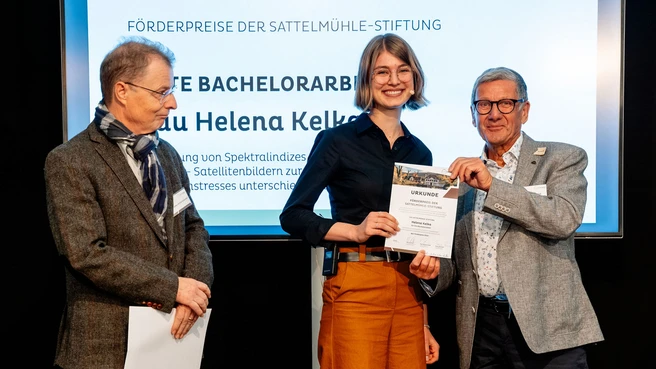Between 2018 and 2023, Europe experienced several periods of severe summer drought. In her thesis, Helena Kelka analyzed test areas at the Linde Research Station in Brandenburg that were severely affected by this. She worked with satellite images from Sentinel-2, the environmental satellite from the European space program.
Her bachelor's thesis in the Forest Sciences and Resource Management degree program addressed the question: To what extent is Sentinel-2 data applicable for mapping the response of pine-dominated forests to drought stress?
Satellite data indicates the condition of vegetation
More specifically, Helena Kelka investigated “whether the spectral indices NDVI and NDMI can reflect the response of Scots pine forests to the drought years from 2018 to 2023” (quote from the summary of the bachelor's thesis).
The NDVI (Normalized Difference Vegetation Index) is well suited for recording the condition of vegetation: high values indicate high leaf biomass, a potentially higher foliar area, and a closed canopy.
The NDMI (Normalized Difference Moisture Index) is sensitive to the moisture content of vegetation and, in this context, describes the water content in the leaf and canopy structure.
The importance of tree species and forest structure
Helena Kelka also investigated how increasing complexity in forest structure and species composition affects the resistance and resilience of these forests to drought.
The complexity of the forest structure refers to two aspects: firstly, the diversity of tree species that form the canopy, and secondly, whether there is undergrowth below the canopy. Undergrowth here refers to all plants up to a height of 10 meters, with a focus on woody species. Figure 2 shows four example test areas with different structures.
Barbara Brunschweiger, a doctoral student working with Prof. Peter Annighöfer who is also involved in the study area, is responsible for grading the forest areas into structure classes.
Mixed forests withstood drought better than pure pine stands
Helena Kelka's bachelor thesis revealed that mixed stands of oak and Scots pine were more resistant to the droughts of recent years and recovered better than pure stands of Scots pine. “Focusing on the different structural classes, Scots pine and oak-dominated mixed stands already reached NDVI values after three years as before the drought in 2018”, Helena Kelka writes in her summary.
Overall, tree species diversity had a greater influence than the presence of undergrowth, although the latter mitigated drought damage somewhat in pure pine stands.
The bachelor's thesis was supervised by Prof. Peter Annighöfer (Professorship of Forest and Agroforest Systems), Prof. Cornelius Senf (Professorship of Earth Observation for Ecosystem Management) and Barbara Brunschweiger.
About the Sattelmühle Foundation Award
The Sattelmühle Foundation hands out awards for bachelor's and master's theses and dissertations. The prizes are intended to encourage outstanding scientific work in forestry and related fields of study such as environmental sciences. The foundation, which was established in Rhineland-Palatinate in 2021, owns a foundation forest, where the award ceremony took place.

